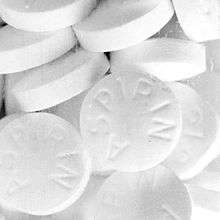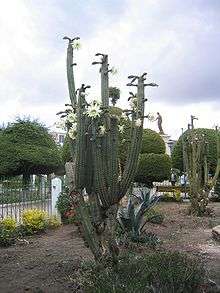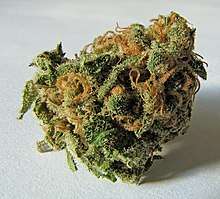Drug
A drug is any substance that causes a change in an organism's physiology or psychology when consumed.[3][4] Drugs are typically distinguished from food and substances that provide nutritional support. Consumption of drugs can be via inhalation, injection, smoking, ingestion, absorption via a patch on the skin, or dissolution under the tongue.

In pharmacology, a drug is a chemical substance, typically of known structure, which, when administered to a living organism, produces a biological effect.[5] A pharmaceutical drug, also called a medication or medicine, is a chemical substance used to treat, cure, prevent, or diagnose a disease or to promote well-being.[3] Traditionally drugs were obtained through extraction from medicinal plants, but more recently also by organic synthesis.[6] Pharmaceutical drugs may be used for a limited duration, or on a regular basis for chronic disorders.[7]
Pharmaceutical drugs are often classified into drug classes—groups of related drugs that have similar chemical structures, the same mechanism of action (binding to the same biological target), a related mode of action, and that are used to treat the same disease.[8][9] The Anatomical Therapeutic Chemical Classification System (ATC), the most widely used drug classification system, assigns drugs a unique ATC code, which is an alphanumeric code that assigns it to specific drug classes within the ATC system. Another major classification system is the Biopharmaceutics Classification System. This classifies drugs according to their solubility and permeability or absorption properties.[10]
Psychoactive drugs are chemical substances that affect the function of the central nervous system, altering perception, mood or consciousness.[11] These drugs are divided into different groups like: stimulants, depressants, antidepressants, anxiolytics, antipsychotics, and hallucinogens. These psychoactive drugs have been proven useful in treating wide range of medical conditions including mental disorders around the world. The most widely used drugs in the world include caffeine, nicotine and alcohol,[12] which are also considered recreational drugs, since they are used for pleasure rather than medicinal purposes.[13] Abuse of several psychoactive drugs can cause psychological or physical addiction.[14] It's worth noting that all drugs can have potential side effects.[15] Excessive use of stimulants can promote stimulant psychosis. Many recreational drugs are illicit and international treaties such as the Single Convention on Narcotic Drugs exist for the purpose of their prohibition.
Etymology
In English, the noun "drug" is thought to originate from Old French "drogue", possibly deriving from "droge (vate)" from Middle Dutch meaning "dry (barrels)", referring to medicinal plants preserved as dry matter in barrels.[16][17]
Medication
A medication or medicine is a drug taken to cure or ameliorate any symptoms of an illness or medical condition. The use may also be as preventive medicine that has future benefits but does not treat any existing or pre-existing diseases or symptoms. Dispensing of medication is often regulated by governments into three categories—over-the-counter medications, which are available in pharmacies and supermarkets without special restrictions; behind-the-counter medicines, which are dispensed by a pharmacist without needing a doctor's prescription, and prescription only medicines, which must be prescribed by a licensed medical professional, usually a physician.[18]
In the United Kingdom, behind-the-counter medicines are called pharmacy medicines which can only be sold in registered pharmacies, by or under the supervision of a pharmacist. These medications are designated by the letter P on the label.[19] The range of medicines available without a prescription varies from country to country. Medications are typically produced by pharmaceutical companies and are often patented to give the developer exclusive rights to produce them. Those that are not patented (or with expired patents) are called generic drugs since they can be produced by other companies without restrictions or licenses from the patent holder.[20]
Pharmaceutical drugs are usually categorised into drug classes. A group of drugs will share a similar chemical structure, or have the same mechanism of action, the same related mode of action or target the same illness or related illnesses.[8][9] The Anatomical Therapeutic Chemical Classification System (ATC), the most widely used drug classification system, assigns drugs a unique ATC code, which is an alphanumeric code that assigns it to specific drug classes within the ATC system. Another major classification system is the Biopharmaceutics Classification System. This groups drugs according to their solubility and permeability or absorption properties.[10]
Spiritual and religious use

Some religions, particularly ethnic religions are based completely on the use of certain drugs, known as entheogens, which are mostly hallucinogens,—psychedelics, dissociatives, or deliriants. Some drugs used as entheogens include kava which can act as a stimulant, a sedative, a euphoriant and an anesthetic. The roots of the kava plant are used to produce a drink which is consumed throughout the cultures of the Pacific Ocean.
Some shamans from different cultures use entheogens, defined as "generating the divine within"[21] to achieve religious ecstasy. Amazonian shamans use ayahuasca (yagé) a hallucinogenic brew for this purpose. Mazatec shamans have a long and continuous tradition of religious use of Salvia divinorum a psychoactive plant. Its use is to facilitate visionary states of consciousness during spiritual healing sessions.[22]
Silene undulata is regarded by the Xhosa people as a sacred plant and used as an entheogen. Its roots are traditionally used to induce vivid (and according to the Xhosa, prophetic) lucid dreams during the initiation process of shamans, classifying it a naturally occurring oneirogen similar to the more well-known dream herb Calea ternifolia.[23]
Peyote a small spineless cactus has been a major source of psychedelic mescaline and has probably been used by Native Americans for at least five thousand years.[24][25] Most mescaline is now obtained from a few species of columnar cacti in particular from San Pedro and not from the vulnerable peyote.[26]
The entheogenic use of cannabis has also been widely practised [27] for centuries.[28] Rastafari use marijuana (ganja) as a sacrament in their religious ceremonies.
Psychedelic mushrooms (psilocybin mushrooms), commonly called magic mushrooms or shrooms have also long been used as entheogens.
Smart drugs and designer drugs
Nootropics, also commonly referred to as "smart drugs", are drugs that are claimed to improve human cognitive abilities. Nootropics are used to improve memory, concentration, thought, mood, and learning. An increasingly used nootropic among students, also known as a study drug, is methylphenidate branded commonly as Ritalin and used for the treatment of attention deficit hyperactivity disorder (ADHD) and narcolepsy.[29] At high doses methylphenidate can become highly addictive.[30] Serious addiction can lead to psychosis, anxiety and heart problems, and the use of this drug is related to a rise in suicides, and overdoses. Evidence for use outside of student settings is limited but suggests that it is commonplace.[29][30] Intravenous use of methylphenidate can lead to emphysematous damage to the lungs, known as Ritalin lung.[31]
Other drugs known as designer drugs are produced. An early example of what today would be labelled a 'designer drug' was LSD, which was synthesised from ergot.[32] Other examples include analogs of performance-enhancing drugs such as designer steroids taken to improve physical capabilities and these are sometimes used (legally or not) for this purpose, often by professional athletes.[33] Other designer drugs mimic the effects of psychoactive drugs. Since the late 1990s there has been the identification of many of these synthesised drugs. In Japan and the United Kingdom this has spurred the addition of many designer drugs into a newer class of controlled substances known as a temporary class drug.
Synthetic cannabinoids have been produced for a longer period of time and are used in the designer drug synthetic cannabis.
Recreational drug use
Recreational drug use is the use of a drug (legal, controlled, or illegal) with the primary intention of altering the state of consciousness through alteration of the central nervous system in order to create positive emotions and feelings. The hallucinogen LSD is a psychoactive drug commonly used as a recreational drug.[35]
Some national laws prohibit the use of different recreational drugs; and medicinal drugs that have the potential for recreational use are often heavily regulated. However, there are many recreational drugs that are legal in many jurisdictions and widely culturally accepted. Cannabis is the most commonly consumed controlled recreational drug in the world (as of 2012).[36] Its use in many countries is illegal but is legally used in several countries usually with the proviso that it can only be used for personal use. It can be used in the leaf form of marijuana (grass), or in the resin form of hashish. Marijuana is a more mild form of cannabis than hashish.
There may be an age restriction on the consumption and purchase of legal recreational drugs. Some recreational drugs that are legal and accepted in many places include alcohol, tobacco, betel nut, and caffeine products, and in some areas of the world the legal use of drugs such as khat is common.[37]
There are a number of legal intoxicants commonly called legal highs that are used recreationally. The most widely used of these is alcohol.
Administration of drugs
All drugs, can be administered via a number of routes, and many can be administered by more than one.
- Bolus is the administration of a medication, drug or other compound that is given to raise its concentration in blood to an effective level. The administration can be given intravenously, by intramuscular, intrathecal or subcutaneous injection.
- Inhaled, (breathed into the lungs), as an aerosol or dry powder. (This includes smoking a substance)
- Injection as a solution, suspension or emulsion either: intramuscular, intravenous, intraperitoneal, intraosseous.
- Insufflation, or snorted into the nose.
- Orally, as a liquid or solid, that is absorbed through the intestines.
- Rectally as a suppository, that is absorbed by the rectum or colon.
- Sublingually, diffusing into the blood through tissues under the tongue.
- Topically, usually as a cream or ointment. A drug administered in this manner may be given to act locally or systemically.[38]
- Vaginally as a pessary, primarily to treat vaginal infections.
Control of drugs
There are numerous governmental offices in many countries that deal with the control and oversee of drug manufacture and use, and the implementation of various drug laws. The Single Convention on Narcotic Drugs is an international treaty brought about in 1961 to prohibit the use of narcotics save for those used in medical research and treatment. In 1971, a second treaty the Convention on Psychotropic Substances had to be introduced to deal with newer recreational psychoactive and psychedelic drugs.
The legal status of Salvia divinorum varies in many countries and even in states within the United States. Where it is legislated against the degree of prohibition also varies.
The Food and Drug Administration (FDA) in the United States is a federal agency responsible for protecting and promoting public health through the regulation and supervision of food safety, tobacco products, dietary supplements, prescription and over-the-counter medications, vaccines, biopharmaceuticals, blood transfusions, medical devices, electromagnetic radiation emitting devices, cosmetics, animal foods[39] and veterinary drugs.
See also
References
- Geoffrey Burchfield (1997). Meredith Hopes (ed.). "What's your poison: caffeine". Australian Broadcasting Corporation. Archived from the original on 26 July 2009. Retrieved 15 January 2014.
- Richard Lovett (24 September 2005). "Coffee: The demon drink?". Archived from the original on 11 April 2014. Retrieved 2014-05-01.
- "Drug". Dictionary.com Unabridged. v 1.1. Random House. 20 September 2007. Archived from the original on 14 September 2007 – via Dictionary.com.
- "Drug Definition". Stedman's Medical Dictionary. Archived from the original on 2014-05-02. Retrieved 2014-05-01 – via Drugs.com.
- H.P., Rang; M.M, Dale; J.M., Ritter; R.J., Flower; G., Henderson (2011). "What is Pharmacology". Rang & Dale's pharmacology (7th ed.). Edinburgh: Churchill Livingstone. p. 1. ISBN 978-0-7020-3471-8.
a drug can be defined as a chemical substance of known structure, other than a nutrient of an essential dietary ingredient, which, when administered to a living organism, produces a biological effect
- Atanasov AG, Waltenberger B, Pferschy-Wenzig EM, Linder T, Wawrosch C, Uhrin P, Temml V, Wang L, Schwaiger S, Heiss EH, Rollinger JM, Schuster D, Breuss JM, Bochkov V, Mihovilovic MD, Kopp B, Bauer R, Dirsch VM, Stuppner H (December 2015). "Discovery and resupply of pharmacologically active plant-derived natural products: A review". Biotechnol Adv. 33 (8): 1582–614. doi:10.1016/j.biotechadv.2015.08.001. PMC 4748402. PMID 26281720.
- "Drug". The American Heritage Science Dictionary. Houghton Mifflin Company. Archived from the original on 14 September 2007. Retrieved 20 September 2007 – via dictionary.com.
- Mahoney A, Evans J (6 November 2008). "Comparing drug classification systems". AMIA Annual Symposium Proceedings: 1039. PMID 18999016.
- World Health Organization (2003). Introduction to drug utilization research (PDF). Geneva: World Health Organization. p. 33. ISBN 978-92-4-156234-8. Archived (PDF) from the original on 2016-01-22.
- Bergström, CA; Andersson, SB; Fagerberg, JH; Ragnarsson, G; Lindahl, A (16 June 2014). "Is the full potential of the biopharmaceutics classification system reached?". European Journal of Pharmaceutical Sciences. 57: 224–31. doi:10.1016/j.ejps.2013.09.010. PMID 24075971.
- "An overview of alcohol and other drug issues". Archived from the original on 2015-03-28. Retrieved 2015-03-16.
- Crocq MA (June 2003). "Alcohol, nicotine, caffeine, and mental disorders". Dialogues Clin. Neurosci. 5 (2): 175–185. PMC 3181622. PMID 22033899.
- "Recreational Drug". The Free Dictionary. Retrieved 16 March 2015.
- Fox, Thomas Peter; Oliver, Govind; Ellis, Sophie Marie (2013). "The Destructive Capacity of Drug Abuse: An Overview Exploring the Harmful Potential of Drug Abuse Both to the Individual and to Society". ISRN Addiction. 2013: 450348. doi:10.1155/2013/450348. PMC 4392977. PMID 25938116.
- "MHRA Side Effects of Medicines." Archived 2014-05-02 at the Wayback Machine MHRA Side Effects of Medicines,
- Harper, Douglas. "drug". Online Etymology Dictionary.
- Tupper KW (2012). "Psychoactive substances and the English language: "Drugs," discourses, and public policy". Contemporary Drug Problems. 39 (3): 461–492. doi:10.1177/009145091203900306.
- "About Registration: Medicines and Prescribing". Health and Care Professions Council. Archived from the original on 2016-01-13. Retrieved 22 January 2016.
- "Glossary of MHRA terms – P". U.K. Medicines and Healthcare products Regulatory Agency. Archived from the original on 2008-11-14. Retrieved 2008-11-05.
- ""Generic Drugs", Center for Drug Evaluation and Research, U.S. Food and Drug Administration" (PDF). Fda.gov. Archived (PDF) from the original on 29 August 2017. Retrieved 11 October 2017.
- Entheogen, [dictionary.com], archived from the original on 2012-02-13, retrieved 2012-03-13
- Valdés, Díaz & Paul 1983, p. 287.
- Sobiecki, Jean-Francois (July 2012). "Psychoactive Spiritual Medicines and Healing Dynamics in the Initiation Process of Southern Bantu Diviners". Journal of Psychoactive Drugs. 44 (3): 216–223. doi:10.1080/02791072.2012.703101. PMID 23061321.
- El-Seedi HR, De Smet PA, Beck O, Possnert G, Bruhn JG (October 2005). "Prehistoric peyote use: alkaloid analysis and radiocarbon dating of archaeological specimens of Lophophora from Texas". J Ethnopharmacol. 101 (1–3): 238–42. doi:10.1016/j.jep.2005.04.022. PMID 15990261.
- "A Brief History of the San Pedro Cactus". Mescaline.com. Archived from the original on 28 September 2016. Retrieved 11 October 2017.
- Terry M (2013). "Lophophora williamsii". IUCN Red List of Threatened Species. 2013. doi:10.2305/IUCN.UK.2013-1.RLTS.T151962A581420.en. Retrieved 2018-10-29.
- Monteiro, Júlio Marcelino; Albuquerque, Ulysses Paulino de. "Brazilian Archives of Biology and Technology – Jurema-Preta (Mimosa tenuiflora [Willd.] Poir.): a review of its traditional use, phytochemistry and pharmacology". Brazilian Archives of Biology and Technology. scielo.br. 51 (5): 937–947. doi:10.1590/S1516-89132008000500010. Archived from the original on 2009-03-07. Retrieved 2009-01-14.
- Bloomquist, Edward (1971). Marijuana: The Second Trip. California: Glencoe.
- Abelman, D (6 October 2017). "Mitigating risks of students use of study drugs through understanding motivations for use and applying harm reduction theory: a literature review". Harm Reduct J. 14 (1): 68. doi:10.1186/s12954-017-0194-6. PMC 5639593. PMID 28985738.
- Smith, M; Farah, M (September 2011). "Are prescription stimulants "smart pills"? The epidemiology and cognitive neuroscience of prescription stimulant use by normal healthy individuals". Psychol. Bull. 137 (5): 717–41. doi:10.1037/a0023825. PMC 3591814. PMID 21859174.
- Sharma, R. "Ritalin lung". Radiopedia.org. Retrieved 1 July 2019.
- "Discovery And Synthesis Of LSD: What You Probably Did Not Know About It - Chemistry Hall". 2017-06-13. Archived from the original on 2017-06-13. Retrieved 2017-06-13.
- Teale P, Scarth J, Hudson S (2012). "Impact of the emergence of designer drugs upon sports doping testing". Bioanalysis. 4 (1): 71–88. doi:10.4155/bio.11.291. PMID 22191595.
- Lingeman. Drugs from A–Z: A Dictionary. Penguin. ISBN 978-0-7139-0136-8.
- "DrugFacts: Hallucinogens - LSD, Peyote, Psilocybin, and PCP". National Institute on Drug Abuse. December 2014. Archived from the original on February 16, 2015. Retrieved February 17, 2015.
- "World Drug Report 2012" (PDF). UNODC. 2012. p. 69. Archived (PDF) from the original on 13 July 2012. Retrieved 9 December 2016.
- Al-Mugahed, Leen (2008). "Khat Chewing in Yemen: Turning over a New Leaf: Khat Chewing Is on the Rise in Yemen, Raising Concerns about the Health and Social Consequences". Bulletin of the World Health Organization. 86 (10): 741–2. doi:10.2471/BLT.08.011008. PMC 2649518. PMID 18949206. Archived from the original on 10 March 2016. Retrieved 22 January 2016.
- "The administration of medicines". Nursing Times. EMAP Publishing Limited. 19 November 2007. Archived from the original on 17 June 2010. Retrieved 11 January 2016.
- "Animal Food & Feeds". Fda.gov. Archived from the original on 22 March 2015. Retrieved 14 March 2015.
Further reading
- Richard J. Miller (2014). Drugged: the science and culture behind psychotropic drugs. Oxford University Press. ISBN 978-0-19-995797-2.
External links
- DrugBank, a database of 13,400 drugs and 5,100 protein drug targets
- "Drugs", BBC Radio 4 discussion with Richard Davenport-Hines, Sadie Plant and Mike Jay (In Our Time, May 23, 2002)
| Wikimedia Commons has media related to Drugs. |

